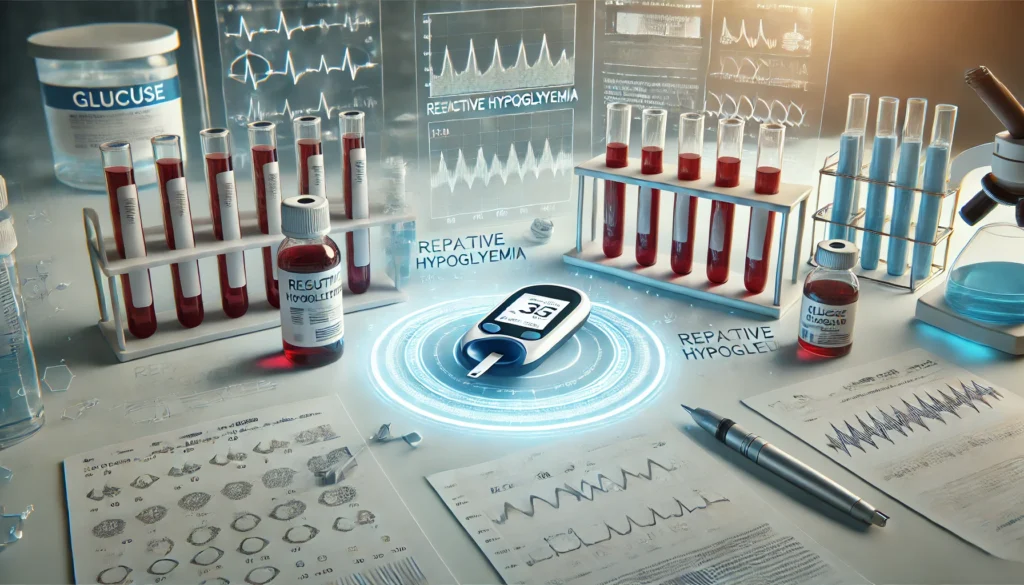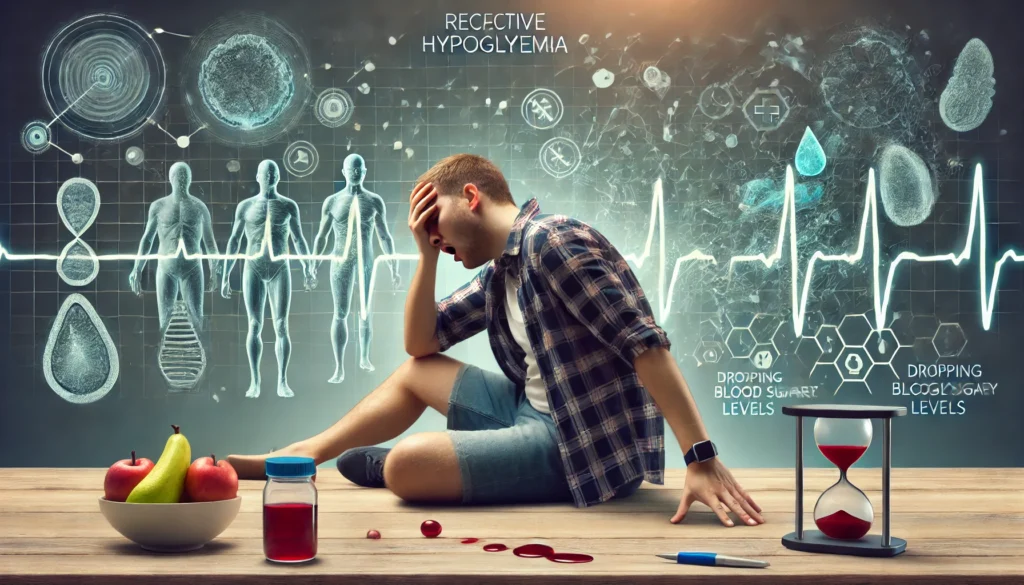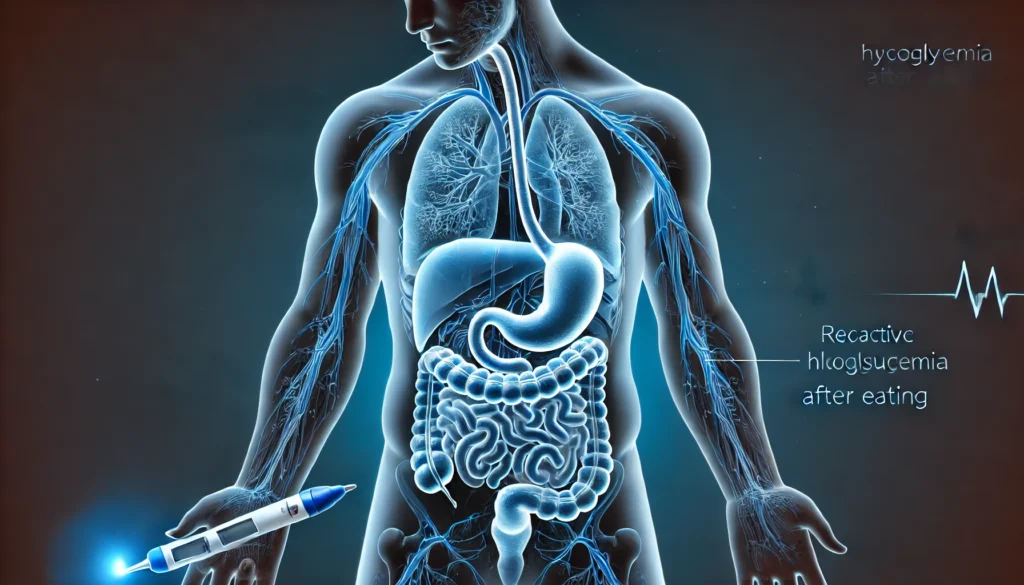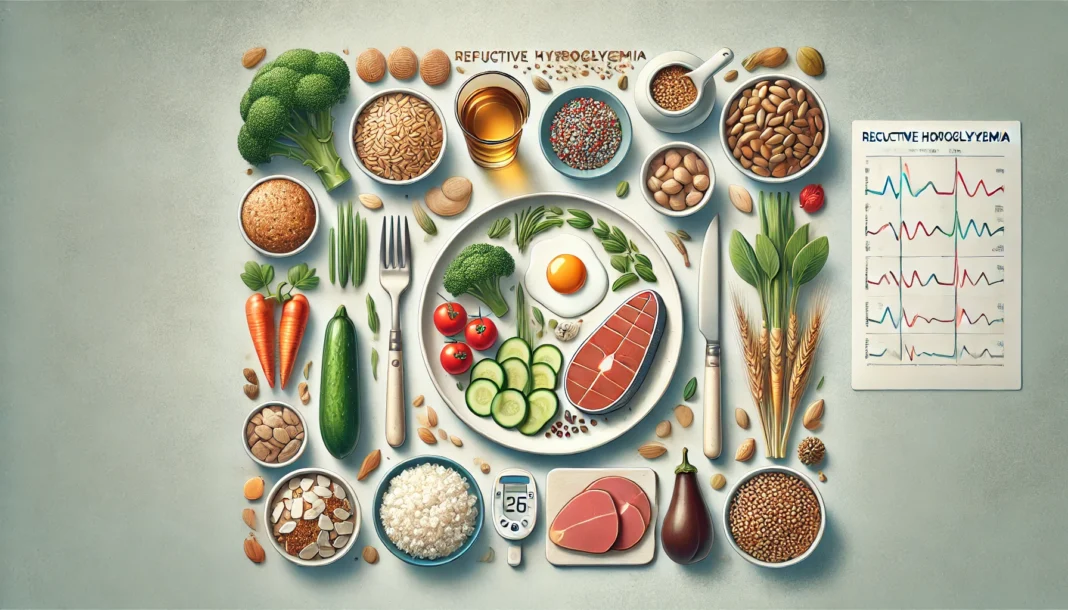Understanding Reactive Hypoglycemia: A Scientific Perspective
Reactive hypoglycemia, often referred to as postprandial hypoglycemia, is a condition in which blood sugar decreases after eating, typically within four hours of a meal. Unlike fasting hypoglycemia, which occurs due to prolonged periods without food, reactive hypoglycemia is triggered by an excessive insulin response following carbohydrate consumption. Although commonly associated with diabetes, it can also occur in individuals without the disease. Understanding this phenomenon requires a thorough examination of its causes, symptoms, and treatment options.
You may also like: How Diabetes Affects the Brain: Understanding Brain Fog, Memory Loss, and Mental Confusion from High Blood Sugar
The Physiological Mechanisms Behind Reactive Hypoglycemia
The body maintains glucose homeostasis through a tightly regulated system involving insulin and glucagon. After eating, carbohydrates are broken down into glucose, which enters the bloodstream and signals the pancreas to release insulin. This hormone facilitates glucose uptake into cells, providing energy. However, in cases of reactive hypoglycemia, an exaggerated insulin release leads to a rapid drop in blood glucose levels. This decline triggers symptoms such as shaking, sweating, dizziness, and, in severe cases, confusion or loss of consciousness.
Several factors contribute to the excessive insulin response characteristic of reactive hypoglycemia. One primary cause is insulin resistance, where cells become less responsive to insulin, prompting the pancreas to overproduce the hormone. Additionally, individuals who have undergone gastric bypass surgery may experience rapid glucose absorption, leading to an exaggerated insulin surge. Furthermore, hormonal imbalances, including dysfunction in the adrenal or pituitary glands, can also contribute to the condition by disrupting normal glucose regulation.

Identifying the Symptoms of Reactive Hypoglycemia
Recognizing the symptoms of reactive hypoglycemia is crucial for early intervention and proper management. Many individuals report feeling shaky after eating, a sensation often accompanied by sweating, rapid heartbeat, and dizziness. These symptoms arise as the body attempts to compensate for the sudden drop in blood glucose by releasing counterregulatory hormones such as epinephrine.
Beyond physical manifestations, reactive hypoglycemia can affect cognitive function and mood. Some individuals experience difficulty concentrating, irritability, or even mild confusion, which can be mistaken for other conditions. In more severe cases, hypoglycemia can lead to fainting or seizures, particularly if blood sugar levels drop to critically low levels. While these symptoms may resemble those of diabetes-related hypoglycemia, it is important to note that reactive hypoglycemia occurs in individuals with normal baseline glucose regulation.
The Role of Diet in Managing Reactive Hypoglycemia
Dietary modifications play a pivotal role in preventing and managing reactive hypoglycemia. One of the most effective strategies is to adopt a low-glycemic diet, which involves consuming foods that cause a gradual rise in blood sugar rather than a rapid spike. Complex carbohydrates, such as whole grains, legumes, and non-starchy vegetables, provide sustained energy release and reduce the likelihood of excessive insulin secretion.
Additionally, incorporating protein and healthy fats into meals helps stabilize blood sugar levels. These macronutrients slow down carbohydrate digestion and absorption, minimizing abrupt fluctuations in glucose levels. For example, pairing whole-grain toast with avocado and eggs can provide a balanced meal that prevents postprandial hypoglycemia. Moreover, avoiding refined sugars and high-glycemic foods, such as white bread, pastries, and sugary beverages, is essential in reducing the risk of blood sugar crashes.
The Impact of Meal Timing and Frequency
Beyond food choices, meal timing and frequency significantly influence blood sugar regulation. Many individuals with reactive hypoglycemia benefit from consuming smaller, more frequent meals throughout the day rather than relying on three large meals. This approach prevents excessive insulin release and maintains steady glucose levels.
Eating a balanced breakfast is particularly important in mitigating morning hypoglycemia. Skipping breakfast or consuming a carbohydrate-heavy meal without protein and fat can lead to a rapid blood sugar increase followed by a crash. Instead, a meal rich in protein, healthy fats, and fiber can sustain energy levels and prevent morning hypoglycemia. Furthermore, individuals prone to reactive hypoglycemia should avoid long periods without eating, as prolonged fasting can exacerbate blood sugar instability.
The Connection Between Stress and Blood Sugar Regulation
Stress plays a significant role in glucose metabolism and can contribute to reactive hypoglycemia. During stress, the body releases cortisol and adrenaline, hormones that influence blood sugar levels. While these hormones typically raise glucose availability, chronic stress can lead to dysregulated insulin response, making individuals more susceptible to blood sugar fluctuations.
Practicing stress management techniques, such as meditation, deep breathing, and regular physical activity, can help mitigate the effects of stress on blood sugar regulation. Engaging in mindfulness-based activities can also reduce the likelihood of experiencing hypoglycemia-related symptoms triggered by anxiety and stress.
Medical and Pharmacological Interventions
For individuals who continue to experience severe reactive hypoglycemia despite dietary and lifestyle modifications, medical interventions may be necessary. Blood tests and continuous glucose monitoring can help identify patterns in blood sugar fluctuations, enabling healthcare providers to tailor treatment plans.
In some cases, medications that influence insulin secretion or glucose absorption may be prescribed. For example, alpha-glucosidase inhibitors slow carbohydrate digestion, preventing rapid glucose absorption and insulin spikes. Additionally, some individuals may benefit from medications that modulate the autonomic nervous system, reducing excessive hormonal responses to blood sugar changes.
The Long-Term Implications of Reactive Hypoglycemia
While reactive hypoglycemia is often manageable through diet and lifestyle adjustments, chronic episodes can increase the risk of developing insulin resistance and, potentially, type 2 diabetes. Repeated blood sugar fluctuations may contribute to metabolic dysfunction, making proactive management essential.
Moreover, individuals who experience frequent episodes of reactive hypoglycemia should be evaluated for underlying metabolic or endocrine disorders. Conditions such as polycystic ovary syndrome (PCOS), adrenal insufficiency, and pancreatic tumors (such as insulinomas) can contribute to abnormal glucose regulation. Addressing these root causes can prevent complications and improve overall health outcomes.

Frequently Asked Questions About Reactive Hypoglycemia and Related Symptoms
1. Why do I feel shaky after eating even if I’m not diabetic?
Feeling shaky after eating, especially when blood sugar levels drop rapidly, may point to reactive hypoglycemia. This condition, sometimes confused with diabetes, involves blood sugar decreases after eating due to an exaggerated insulin response. Interestingly, people experiencing reactive low blood sugar might report a sugar hand shake sensation—where their hands tremble or twitch following carbohydrate intake. Even in individuals without diabetes, this post-meal shaking can occur due to heightened insulin sensitivity or altered glucose metabolism. If you’re shaky when hungry but not diabetic, it may suggest an underlying issue with glucose regulation rather than outright diabetes.
2. Can low blood sugar cause nausea, and how does it feel?
Yes, low blood sugar can cause nausea, particularly during hypoglycemia after eating. This is more common in people who experience reactive hypoglycemia, where a sudden insulin spike causes a blood sugar crash. The nauseated feeling often accompanies other low blood sugar symptoms with no diabetes present, such as dizziness, cold sweats, and a sense of unease. In cases of post hypoglycemia, nausea may persist even after glucose levels normalize due to residual hormonal stress responses. If you frequently deal with hypoglycemia nausea, especially following meals, it’s important to track your eating habits and speak with a healthcare provider to assess glucose tolerance.
3. Is shaking when hungry a sign of diabetes or something else?
While shaking when hungry may raise concerns about diabetes, it doesn’t necessarily mean you have the condition. In many cases, it’s linked to reactive hypoglycemia, which often affects people without diabetes. Shaky when hungry symptoms can result from blood sugar fluctuations, stress hormones like adrenaline, or skipping meals. If you feel shaky but your blood sugar is normal, it could still be a sign of dysregulated glucose handling rather than diabetes itself. Investigating patterns—like how fast your blood sugar drops after eating—can help differentiate between diabetes and reactive hypoglycemia causes.
4. What are some overlooked causes of reactive low blood sugar?
Beyond poor dietary choices, reactive hypoglycemia causes can include hormonal imbalances (like adrenal insufficiency), post-bariatric surgery adaptations, or early signs of metabolic dysfunction. People often notice reactive hypoglycemia in the morning or after consuming high-glycemic foods, triggering blood sugar decreases after eating. Even chronic stress and sleep deprivation can worsen reactive low blood sugar symptoms due to their effects on cortisol and insulin sensitivity. Emerging research also suggests a possible link between gut microbiota imbalances and exaggerated insulin responses. Anyone waking up with low blood sugar or experiencing shaking when hungry should explore these less conventional contributing factors with a health professional.
5. How does reactive hypoglycemia treatment differ from diabetic hypoglycemia?
Reactive hypoglycemia treatment emphasizes dietary timing and macronutrient balance rather than immediate glucose correction, which is often necessary for diabetic hypoglycemia. For instance, reactive hypoglycemia is managed through low-glycemic meals, reduced sugar intake, and frequent small meals to prevent drastic postprandial spikes and crashes. If you’re experiencing symptoms like hypoglycemia nausea, a tailored plan with complex carbs, protein, and fiber can minimize insulin overreaction. People with low blood sugar in the morning often benefit from a balanced bedtime snack to prevent overnight dips. Unlike diabetic hypoglycemia, where insulin dosage is adjusted, reactive low blood sugar responds well to lifestyle and nutritional modifications.
6. Why do I feel temperature changes after eating with low blood sugar?
Some individuals report a peculiar temperature fluctuation—feeling cold then hot, or vice versa—after meals, especially when blood sugar levels drop. This “low blood sugar eat then feel temperature change” pattern is not uncommon in reactive hypoglycemia. It’s driven by the sympathetic nervous system’s response to low glucose, which includes vasoconstriction, sweating, and thermoregulation shifts. In reactive hypoglycemia, the body overcorrects with adrenaline and cortisol, leading to shaky after eating sensations, followed by a temperature rollercoaster. These episodes can become more intense if you frequently experience low blood sugar symptoms with no diabetes diagnosis, particularly when meal composition lacks stable glucose support.
7. What’s the connection between sleep disturbances and hypoglycemia morning symptoms?
Low blood sugar in the morning can stem from overnight glucose dips, often unnoticed until waking. This is especially relevant in reactive hypoglycemia, where delayed insulin activity disrupts the early-morning fasted state. Waking up with low blood sugar may cause symptoms like irritability, dizziness, or even throwing up from hypoglycemia-induced nausea. Individuals with post hypoglycemia effects may feel unusually groggy or confused upon waking, a sign that their body struggled to maintain glucose stability overnight. Adjusting dinner composition and including protein or fat-rich bedtime snacks can help mitigate these hypoglycemia morning episodes and improve sleep quality.
8. Can too much sugar cause low glucose later?
Yes, paradoxically, consuming excessive sugar can lead to low glucose levels afterward—particularly in individuals prone to reactive hypoglycemia. This phenomenon occurs when a surge in simple carbohydrates triggers a spike in insulin, followed by a rapid blood sugar drop. It’s a key reason why sugar hand shake symptoms may appear after dessert or a sugary beverage. For those experiencing feeling shaky after eating, especially high-sugar meals, the culprit may not be insufficient sugar—but too much of it, too fast. Managing reactive hypoglycemia treatment often includes moderating sugar intake to prevent these rebound hypoglycemia symptoms.
9. What can I do if I feel shaky but my blood sugar is normal?
Feeling shaky but blood sugar is normal can be puzzling, but it’s not uncommon in reactive hypoglycemia or autonomic dysfunction. These episodes may mimic hypoglycemia symptoms despite normal glucose levels, particularly in stressful situations or after carbohydrate-rich meals. If you’re experiencing symptoms like being shaky when hungry but not diabetic, tracking your symptoms against meals and stress can be revealing. The nervous system’s reaction to rapid glucose fluctuations—even within normal range—can still produce the hallmark reactive hypoglycemia sensations. Postprandial hypoglycemia treatment in these cases might focus on supporting adrenal function and stabilizing blood glucose variability rather than just correcting numbers.
10. How fast does blood sugar drop after eating in reactive hypoglycemia?
In reactive hypoglycemia, blood sugar can begin to drop as soon as 1–3 hours after a meal, depending on the glycemic load and insulin response. This is particularly true in cases where a high-carb meal leads to a rapid glucose spike, triggering an exaggerated insulin release and subsequent crash. The resulting blood sugar decreases after eating can produce low blood sugar symptoms with no diabetes involved. If you’re shaky after eating or develop hypoglycemia nausea shortly after a meal, this timing can offer a crucial diagnostic clue. Reactive hypoglycemia causes vary, but rapid post-meal dips remain a defining feature—making dietary timing and composition vital for management.

Conclusion: A Proactive Approach to Managing Reactive Hypoglycemia
Reactive hypoglycemia, though often overlooked, is a significant metabolic condition that affects many individuals, even those without diabetes. Understanding its underlying mechanisms, symptoms, and treatment options empowers individuals to take proactive steps in managing their blood sugar levels. By adopting a balanced diet, practicing mindful eating, managing stress, and seeking medical guidance when necessary, individuals can prevent the disruptive effects of reactive hypoglycemia and maintain optimal metabolic health.
reactive hypoglycemia causes, postprandial glucose control, hypoglycemia prevention strategies, low blood sugar effects, managing blood sugar drops, diet for stable glucose levels, symptoms of low blood sugar, endocrine system regulation, glucose metabolism insights, hormonal influence on insulin, blood sugar stability tips, nutritional strategies for hypoglycemia, healthy meal timing, metabolic health optimization, insulin resistance prevention, stress and blood sugar, postprandial metabolic response, glucose monitoring techniques, blood sugar-friendly meals, morning hypoglycemia management
Further Reading:
Metabolic Parameters in Patients with Suspected Reactive Hypoglycemia
Disclaimer: The content published on Better Nutrition News (https://betternutritionnews.com) is for informational and educational purposes only. It is not intended as a substitute for professional medical advice, diagnosis, or treatment. Always seek the guidance of a qualified healthcare professional before making any changes to your diet, nutrition, or wellness practices. The opinions expressed by authors and contributors are their own and do not necessarily reflect those of Better Nutrition News.
Better Nutrition News and its affiliates make no representations or warranties regarding the accuracy, completeness, or reliability of the information provided. We disclaim all liability for any loss, injury, or damage resulting from the use or reliance on the content published on this site. External links are provided for reference purposes only and do not imply endorsement.



